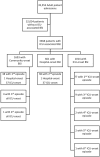Intensive Care Unit-onset Bloodstream Infections Represent a Distinct Category of Hospital-onset Infections: A Multicentre, Retrospective Cohort Study. Queensland Critical Care Network (QCCRN)
- PMID: 40672712
- PMCID: PMC12258631
- DOI: 10.3138/jammi-2024-0023
Intensive Care Unit-onset Bloodstream Infections Represent a Distinct Category of Hospital-onset Infections: A Multicentre, Retrospective Cohort Study. Queensland Critical Care Network (QCCRN)
Abstract
Background: The location of onset of bloodstream infections (BSIs) associated with intensive care unit (ICU) admission may influence their clinical and epidemiological characteristics.
Methods: A multicentre, retrospective cohort study was conducted in Queensland, Australia, and BSIs associated with ICU admission were identified and classified as community-onset, hospital-onset, or ICU-onset if first isolated within, after 48 hours but within 48 hours of ICU admission, or after 48 hours following ICU admission, respectively.
Results: We included 3,540 episodes of ICU-associated BSI, with 1,693 classified as community-onset, 663 hospital-onset, and 1,184 ICU-onset. Compared with hospital-onset BSIs, patients with ICU-onset BSIs were younger, had fewer comorbidities, had lower APACHE II scores, and were more likely male. Patients with ICU-onset BSI were more likely to be surgical admissions and have a primary cardiovascular or neurological diagnosis. The distribution of infective agents varied significantly among community-, hospital-, and ICU-onset BSI groups. The all-cause 30-day case-fatality rates for first-episode community-onset, hospital-onset, and ICU-onset BSIs were 17.1%, 21.7%, and 23.5%, respectively (p < 0.001).
Conclusion: With different epidemiological features and causal pathogens, ICU-onset BSI represents a distinct BSI group arising in hospitalized patients.
Historique: Le foyer d'apparition des infections transmissibles par le sang (ITSg) associé à l'admission en soins intensifs peut influer sur leurs caractéristiques cliniques et épidémiologiques.
Méthodologie: Les chercheurs ont réalisé une étude de cohorte rétrospective multicentrique à Queensland, en Australie, ont répertorié les ITSg associées à une admission en soins intensifs et les ont classées comme d'origine communautaire, d'origine hospitalière ou déclarées en soins intensifs si elles avaient d'abord été isolées dans les 48 heures, après 48 heures, mais dans les 48 heures suivant l'admission en soins intensifs ou plus de 48 heures après l'admission en soins intensifs, respectivement.
Résultats: Les chercheurs ont inclus 3 540 épisodes d'ITSg associés aux soins intensifs, dont 1 693 ont été classées comme d'origine communautaire, 663 comme d'origine hospitalière et 1 184 comme déclarées en soins intensifs. Par rapport aux ITSg d'origine hospitalière, les patients atteints d'une ITSg déclarée en soins intensifs étaient plus jeunes, avaient des maladies connexes, avaient des scores APACHE II plus faibles et étaient plus susceptibles d’être de sexe masculin. Les patients atteints d'une ITSg déclarée en soins intensifs étaient plus susceptibles d'avoir été hospitalisés en vue d'une opération et d'avoir un diagnostic cardiovasculaire ou neurologique primaire. La répartition des agents infectieux variait considérablement dans les groupes atteints d'une ITSg d'origine communautaire, d'origine hospitalière ou déclarée en soins intensifs. Le taux de fatalité toutes causes confondues au bout de 30 jours en cas de premier épisode d'ISTg d'origine communautaire, d'origine hospitalière et déclarée en soins intensifs s’élevait à 17,1%, 21,7% et 23,5%, respectivement (p < 0,001).
Conclusion: Compte tenu de leurs caractéristiques épidémiologiques distinctives et de leurs agents pathogènes causaux, les ITSg s’étant déclarées en soins intensifs représentent un groupe d'ITSg distinctes chez les patients hospitalisés.
Keywords: bloodborne infections; epidemiology; infection control; sepsis.
© Association of Medical Microbiology and Infectious Disease Canada (AMMI Canada), 2024.
Conflict of interest statement
The authors have nothing to disclose.
Figures
Similar articles
-
The impact of inpatient bloodstream infections caused by antibiotic-resistant bacteria in low- and middle-income countries: A systematic review and meta-analysis.PLoS Med. 2023 Jun 22;20(6):e1004199. doi: 10.1371/journal.pmed.1004199. eCollection 2023 Jun. PLoS Med. 2023. PMID: 37347726 Free PMC article.
-
Exercise rehabilitation following intensive care unit discharge for recovery from critical illness.Cochrane Database Syst Rev. 2015 Jun 22;2015(6):CD008632. doi: 10.1002/14651858.CD008632.pub2. Cochrane Database Syst Rev. 2015. PMID: 26098746 Free PMC article.
-
Melatonin for the promotion of sleep in adults in the intensive care unit.Cochrane Database Syst Rev. 2018 May 10;5(5):CD012455. doi: 10.1002/14651858.CD012455.pub2. Cochrane Database Syst Rev. 2018. PMID: 29746721 Free PMC article.
-
Magnesium sulfate for acute exacerbations of chronic obstructive pulmonary disease.Cochrane Database Syst Rev. 2022 May 26;5(5):CD013506. doi: 10.1002/14651858.CD013506.pub2. Cochrane Database Syst Rev. 2022. PMID: 35616126 Free PMC article.
-
Home treatment for mental health problems: a systematic review.Health Technol Assess. 2001;5(15):1-139. doi: 10.3310/hta5150. Health Technol Assess. 2001. PMID: 11532236
References
LinkOut - more resources
Full Text Sources


